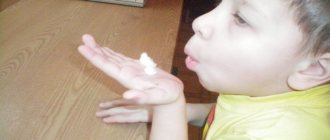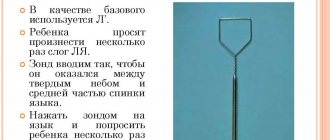Basic recommendations and exercises
Each “training” day will need to start with a warm-up.
This is important in order to warm up the child’s articulatory apparatus before performing the exercises. For example, you can ask your baby to “brush” his upper teeth with his tongue
To do this, you need to smile and walk the tip along the inner surface of the row. At the same time, you need to make sure that his jaw remains in place. Another warm-up option can be regular clattering. The fact is that the technique of making the sound characteristic of a horse is somewhat reminiscent of the pronunciation of “R”. And you can laugh with your baby while doing the exercise - who sticks out their tongue further. His trick is to try to say something with this position of the tongue.
It is important to complete all assigned tasks together. The child must see the articulation and facial expressions of the adult, and not just hear
In childhood, the first thing everyone learns is to imitate. The main thing is to be patient, as some exercises can take several months to perform correctly. Under no circumstances should you give up and stop smiling. You really need to treat exercise like a fun game. More precisely, make them like this. And then, after establishing the correct pronunciation of the sound, it will be possible to move on to syllables and simple words. If all the above conditions are met, parents will be able to achieve tangible success with their child. One day, he will easily and simply be able to master continuous speech with a difficult-to-pronounce letter. Don't forget to celebrate this occasion with a delicious cake.
Advertisement
Study Materials
Poetry
* * * An avalanche of glorious “Ls” is pouring down - They hit me on the head like a downpour, These “Ls” love me, They stick like I’m Lucy.
Poems about the letter "L"
Puzzles
* * * Leo - he is a lion, he is the king of beasts, Because he is bolder than everyone else. The lion is trying on an overcoat, And the overcoat is under the letter...
Riddles about the letter "L"
Tongue Twisters
* * * The letter L rocks our tiny Yulka in the cradle. She pushes the cradle with her legs, Yulka falls asleep in the cradle.
Tongue twisters starting with the letter "L"
Fairy tales
Exercises and tips
If your speech therapist has not identified any serious deviations, then you can safely begin exercises on making the sound “l” at home. First of all, we need to determine how we produce this sound (interestingly, the position of the tongue may differ slightly among different people with normal diction).
Correct position of articular organs
- The tip of the tongue rests on the base of the upper teeth (it can also be on the upper alveoli or rests on the gap between the upper and lower teeth).
- The air passes along the sides of the tongue (the air flow needs to be quite strong).
- The lateral edges of the tongue do not rest against the upper or lower lateral teeth.
Usually the sound “l” is placed without much difficulty (sometimes a few lessons are enough). We will give tips on how to help your child learn to pronounce the letter “l” at home. Combine exercises with articulation gymnastics, which will help improve the mobility of the lips, tongue, and laryngeal muscles. Children usually like these activities because they can make faces to their heart's content.
Exercises for training "l"
- Smile. You need to smile from ear to ear, without opening your lips, and stay in this position for up to ten seconds (7-8 times a day).
- Breeze. Open your mouth a little, bite your tongue a little with your lips and blow hard (up to three minutes a day).
- Delicious jam. Circular movements of the tongue over the lips, as if we are licking something tasty (1 minute).
- Clattering. Ask your baby to click like a horse, gradually speeding up. In this case, the lower jaw should remain motionless. Then do the same exercise, only more quietly, as if the horse is sneaking.
- Long tongue. Invite your baby to stick out his tongue as far as possible and try to reach either his chin or his nose.
- Tube. Roll your tongue into a tube several times a day - it’s both useful and fun.
- The sound is "y". Ask to say “y-y-y”, but so that the tip of the tongue is in the back of the mouth, and its back is raised to the palate.
- Breath. Do breathing exercises more often: blow soap bubbles, blow on dandelions and lighted candles, instill in your child an interest in singing.
- Fine motor skills. Do modeling, sewing, drawing, applique more often - stimulation of the nerve endings on the hands will help in the development of speech and intellectual development in general.
How to organize classes correctly
First of all, we must remember that all exercises should be done in the form of a game. Think in advance about how you will work with your baby, because just one wrong move or word can put pressure on the child, and he will refuse the procedure. Please note that the child cannot always understand the deep meaning and significance of speech therapy exercises for his future, so the atmosphere of the game is very important. Start small, 1-2 exercises a day, so as not to overtire your baby. Conduct classes so that the child can clearly see his and your face, that is, in front of a mirror, with normal lighting, and preferably in a sitting position. The main thing is to remember to praise your child as often as possible.
The feasibility of speech therapy classes
Some parents do not think about how to teach their child to say the letter L. They do not consider the defect to be something serious, but in adult life it will become the basis of complexes and worries.
Important! It is better to correct speech disorders in preschool age, then the process will take a little time.
Do-it-yourself didactic material for kindergarten
If parents do not know how to correctly teach their child to pronounce the letters L and R, then they should contact a specialist. A speech therapist will be able to correct this problem and develop the desired pronunciation.
How many lessons does it take to produce sound [l]
It is impossible to say with certainty how many lessons will be required to eliminate the defect. Sometimes sound production takes one session, in other situations it will take more than 30-40 meetings.
It all depends on the characteristics of the child, his motivation and the interest of the parents. Learning to pronounce the sound [l] is not so easy, since a preschooler gets used to a certain stereotype. Due to their age, it is still difficult for children to perceive learning activities.
How does an individual sound production lesson work [l]
The speech therapist performs sound production only after the student performs articulatory gymnastics well. The complex is performed strictly in front of a mirror. Afterwards they do breathing exercises and perform speech hearing tasks.
How does an individual lesson on sound automation work [l]
The speech therapist conducts individual lessons on automating the sound [l] only after calling an isolated pronunciation. At such lessons, the specialist develops the lexical and grammatical structure of speech, phonetic and phonemic hearing.
To do this, use different games and simulators. Modern speech therapists use computer games. Parents are required to participate in the process and carry out the specialist’s tasks at home.
Important! The duration of the lesson for preschool age is approximately 25 minutes. Physical minutes are required to switch activities.
How to teach a child to pronounce the letter “R”?
You should start with articulation: the teeth open, the tongue is folded in the shape of a boat, its sides should touch the teeth, and the tip should rise and touch the incisors.
The language is set as for pronouncing the letter “P”, but the sound “ZZZZZZZHZH” is pronounced repeatedly, and then “D”.
The baby sticks out his tongue and presses it with his lips, after which he should quickly exhale through his mouth, causing the end of the tongue to vibrate slightly.
The child opens his mouth, spreads his tongue so that its tip touches the front incisors, and the sides touch the molars. You need to hold your tongue in this position for a few seconds, and then completely relax it. Repeat 3-4 times.
The child should open his mouth, slightly parting his lips, and lightly bite the tip of his tongue 10 times.
Let the baby try to click his tongue while sucking it to the roof of his mouth. You need to repeat the exercise at least 10 times, changing the pace.
Invite your child to try imitating the clatter of a horse's hooves with his tongue.
The baby sharply and quickly hits the upper teeth with the tip of his tongue and at the same time pronounces the sound “D”.
Game techniques
Parents wondering to teach their child to pronounce the letter “R”
Often they are faced with the fact that the baby does not want to complete tasks and articulation exercises because he is bored and uninterested. How to be in this case? There are special educational games that train the pronunciation of the letter “R”.
An adult invites the child to imitate the oscillations of a clock pendulum with his tongue. To do this, the baby opens his mouth wide, sticks out his tongue and reaches out to the right and left corners of his mouth.
"Hide and Seek"
The adult tells the baby that the tongue loves to walk, but is very shy. Therefore, you need to learn to stick it out when no one sees it. After these explanations, the adult closes his eyes and the tongue goes for a walk - it sticks out of the mouth, and when the adult opens his eyes, the tongue hides.
"Komarik"
Ask your child what sounds a mosquito makes; if the little one doesn’t know how to answer, tell him: “zzzzzzzzzzzzzzzzzzzzzzzzzzzzzzzzzzzzzzzzzzzzzzzzzzzzzzzzzzzzzzzzzzzzzzzzzzzzzzzzzzzzzzzzzzzzzzzzzzzzzzzz out of your child.” Have your baby repeat the sound with his mouth closed and open.
The main rule of such games is a friendly environment. If the parents themselves perceive them as an annoying duty and constantly pull the child back and nag at him, then nothing good will come of them. In this case, it is better to seek help from a professional speech therapist.
The development of a child’s speech is an important task facing parents. Many people want to teach their child how to pronounce the letter L correctly as soon as possible. More precisely, the sound is one of the most problematic for many children. Special exercises developed by speech therapists will help with this.
This sound is not a complex one, and errors in its pronunciation can usually be corrected at home, but it is important to remember that the work must be done regularly. A visit to a speech therapist will help parents decide on the basic exercises that the baby will need to do.
Sound correction [l] at home
Speech disorders occur for various reasons. In the case where the child does not speak only one or two sounds, parents can try to correct the defect themselves.
Classes with a speech therapist will help correct any speech problems
How to teach a child to say the letter L hard
With dyslalia, children have problems only with sound pronunciation. Violations arise due to structural features of the articulatory apparatus or insufficient muscle preparation.
For the sound [l], the upper rise of the tip of the tongue is important. This is difficult to do with a short hyoid frenulum. Therefore, it must first be trimmed by a dentist. Only surgery will solve this problem.
It’s easy to check the ligament: you need to ask the child to touch the upper teeth with the tip of his tongue. Sonoras ([l], [r] and their soft pairs) appear by the age of five and until that time there is nothing to worry about. At three years old, the child’s articulatory apparatus is still developing.
Important! There is no need to rush and demand that children pronounce all sounds from an early age. Otherwise, you can provoke the development of a defect.
At home, you can try to correct the incorrect pronunciation of the sound [l] yourself. This is only allowed in the case of dyslalia. Sometimes this problem can be confused with dysarthria, which requires work with a speech therapist.
With dysarthria, the mobility of the muscles of the articulatory apparatus is impaired. A similar problem is expressed in hypertonicity or hypotonicity. Often the tongue of such a child is bunched up in the mouth or is too relaxed. It will be difficult for your baby to perform fine movements and switch from one position to another.
Correcting incorrect pronunciation may take up to one year. You need to work with your child every day - this will speed up the process. It is necessary to follow the sequence of stages and not rush.
Sound production
The mechanical method is often used in speech therapy. It requires a special probe in the form of a wire frame or a spatula. The child opens his mouth wide, pronounces “YYYYYY” in a drawn-out manner, and at this time the adult lifts his tongue with an instrument.
It is easier to teach a child to pronounce a sound from the interdental position. To do this, the preschooler is asked to bite the tip of the tongue and pronounce the sound [s] (YYYYYYY), and then gradually remove the tongue behind the upper teeth.
You can pronounce [l] in the interdental position immediately with syllables. Gradually we are moving away from this situation. Automation begins only with direct syllables: LA, LO, LY, LE.
Important! You cannot rush to move on to words, otherwise defective pronunciation will become entrenched.
Stages of teaching correct sound pronunciation to preschoolers
Sound Automation
After the correct pronunciation has been worked out in forward and backward syllables, they move on to words. To facilitate perception, visual material is used in the form of pictures and special games. For example, a child is asked to show objects with the sound [l].
Syllables can be pronounced using a probe
It is difficult to teach a preschooler to exercise self-control. Therefore, you need to constantly work with him. It is enough to devote less than half an hour to work and the effect will not be long in coming.
Parents should understand that there is no method that will give quick results. Only constant training will help you consolidate correct pronunciation.
Songs and rhymes
To facilitate the automation process, different lexical material is used. Pure sayings and poetic forms are easier to remember and the child likes to reproduce them.
You can talk to a preschooler about different topics. This will make it easier for him to get used to the correct pronunciation.
Example of poems for sound automation [l]
The main condition for effective classes is the interest of the student. Therefore, everything is carried out in a playful way. The more varied the material, the better for the baby.
Tongue Twisters
The most difficult thing is to introduce sound into independent speech. To facilitate the process, tongue twisters using the sound [L] are used. They contain words that allow you to practice sound pronunciation in different positions.
For example, “There are pins at the Christmas tree”, “Will in the field”, “I went to Luka’s tray, Luka bought onions from the tray”, etc. Gradually, the child is asked to pronounce each tongue twister faster. Much attention is paid to correct pronunciation.
Articulation exercises
Learning to pronounce a sound correctly begins with articulatory gymnastics. Speech therapy exercises for quickly setting sound [l]:
- The wide tongue lies behind the lower teeth, the child pronounces “YYYYYYYY” in a drawn-out manner.
- Lick your upper lip with the tip of your tongue.
- Click your tongue.
- Open your mouth wide and run your tongue along the inside of your teeth.
- Run the tip of your tongue across the roof of your mouth.
The complex is performed every day. In order for a child to learn to pronounce a sound correctly, he must do all the exercises correctly. In this case, it is important to monitor the immobility of the jaw.
Articulation gymnastics is performed strictly in front of a mirror
After all the movements are easy to perform, move on to the next stage - producing a solid sound [l]. To do this, different techniques are used. It is impossible to say in advance which one will suit a particular child.
Exercises to stretch the hyoid frenulum
You can quickly master the pronunciation of the letter r using a special set of exercises
One of the causes of speech impairment is a short hyoid frenulum. You can cope with this problem yourself at home or with the help of training with a speech therapist. In severe cases, with severe anomalies, surgical dissection of tissue is prescribed.
The following exercises will help you quickly cope with the problem of incorrect sound pronunciation and stretch the hyoid frenulum:
- Swing. To perform this, the preschooler must open his mouth wide and move his tongue up and down, reaching the teeth with the tip of his tongue. It is recommended to hold your tongue for a few seconds at the top and bottom points. A similar training should be done by moving the tongue to the sides.
- Football. There are two options for performing this task. In the first case, the child should touch the inside of the cheek on the right and left with his tongue, in turn, with light pressure. In the second case, you need to roll a small ball from a bandage and place it behind the child’s cheek, and he pushes the ball out with his tongue.
- Kitty. This exercise will be interesting for children of any age. It is enough to pour a little yogurt or other treat into a plate, which the preschooler should lick with his tongue, imitating the movements of a kitten.
- Reach out. The child should reach with his tongue to the tip of his nose, then to his chin. At the peak, you need to fix your tongue for a few seconds.
When performing exercises to stretch the frenulum of the tongue, parents should not be alarmed by the appearance of a small amount of blood. Its separation with a thin frenulum indicates severe stretching or rupture of tissue. If significant bleeding occurs, consult your pediatrician.
A set of exercises for establishing the correct pronunciation of the sound “l”
Before any speech therapy session, it is necessary to warm up the organs of the articulatory apparatus. This is the same warm-up gymnastics.
Children enjoy these activities in a playful way and really enjoy them. Ask your baby to stick his tongue out at you, smile, twirl his pursed lips, and open and close his mouth wide.
Do some breathing exercises. This will be enough to set up the child’s speech apparatus for further work and teach children to pronounce words correctly.
Next, proceed to exercises to pronounce the sound “l”. To make the lessons interesting for your child, use pictures, and not just teach how to pronounce words.
It is also recommended to do all the exercises together with your baby, which will help him see clearly and try to repeat after you.
- Smile. This exercise is very fun for children. Ask your baby, without opening his lips, to smile from ear to ear and freeze in this position for up to ten seconds.
You can do this up to 8 times.
- Delicious honey. Opening your mouth slightly, use the tip of your tongue to ask your child to lick his lips, as if after tasting delicious honey. The exercise should be done for at least one minute.
- Breeze. Blow air through a slightly open mouth, while biting the tip of your tongue. The exercise is performed for about three minutes.
- The clatter of a horse. Show pictures. Ask your baby what kind of animal this is and ask him to just click his tongue, like a horse does. First, speed up the pronunciation of the sound, and then muffle it.
- Show me your tongue. This exercise is also very entertaining for children, as adults allow him to do things that were previously prohibited. Ask your child to push his tongue forward as much as possible and try to reach his chin. The next step is to reach the tip of the nose.
If parents are faced with the task of teaching their child to pronounce “l,” then they must remember that the learning process should be interesting for children. To do this, use bright pictures, for example, horses for the exercise of the same name.
The lessons themselves should last no more than 5 minutes, since this is exactly the time when a 4-year-old child can concentrate on completing one task.
Children who have problems pronouncing a word containing the letter “l” should do more drawing, appliqué, that is, fine motor skills exercises. This helps not only to develop speech and teach how to pronounce words correctly, but also contributes to better intellectual development.
Did you like our content? Subscribe to the channel in .
Setting the sound l
Before starting classes, the child must be explained in detail and shown how to pronounce the sound correctly. In this case, a speech therapist or parent must show the child how the articulatory apparatus should work correctly; visual materials can also be used.
Articulation of the sound l
Correct articulation of the sound l: the sharp tongue is raised by the upper teeth, resting on the alvioles (tubercles on the palate located behind the upper teeth). The shape of the tongue in this case resembles a saddle, the air comes out along the edges of the tongue.
Articulation gymnastics for the sound l
There are several ways to produce the sound l, among which the first place is occupied by articulatory gymnastics for forming the sound l. The child will like it due to the fun articular exercises:
- blow soap bubbles, blow on candles, boats on the water;
- “boat”: a relaxed wide tongue should be placed on the lower lip and try to form a boat out of it without lifting it;
- “snake”: stretch your lips, as if in a smile, and extend your sharp, hard tongue forward;
- “the longest tongue”: stick it out as far as possible and try to reach either the chin, the tip of the nose, or the cheeks;
- “horse”: open your mouth, touch your tongue between the upper incisors and tap there so that you get the clatter of horse hooves;
- “turkey”: open your mouth, relax your lips and use your tongue to stroke your upper lip with your tongue moving from top to bottom, saying “bl.”
There are many videos on how to do these exercises to prepare for the sound L. Classes for preschoolers are held in a relaxed atmosphere 1-2 times a day.
A complex of articulatory gymnastics for the sound L in pictures and verses
Age characteristics
The formation of language skills occurs in several stages, so parents should know what speech skills a child should have at a certain age in order to consult with a specialist in time in case of problems.
Stages of speech development:
The first year of life - at 1.5 months, the baby makes vowel sounds (“a”, “u”, “s”). At this time, the formation of the intonation system occurs. At six months the baby begins to babble and even pronounce certain syllables (“ma”, “ba”, “dya”), and by 12 months he is already trying to speak basic words. The function of speech understanding is formed precisely during this period, and after that the process of vocabulary replenishment begins. By the way, the first thing the baby says is not “mom,” as many people think, but “give.” According to statistics, this is typical for 60% of children.
- The second year - during this period the baby begins to understand the speech of adults well. He listens carefully to what others say to him and tries to repeat some words after them. The baby is already talking, but only in his own language. These words are incomprehensible to adults, but parents eventually learn to recognize the baby’s peculiar speech. You can teach a child to talk at 1.5 years old by repeating the same words over and over again, and by the age of 2 years the baby will already be able to pronounce individual phrases (“Mom, give me”, “I want yum-yum”, etc.).
- Third year - at this age, noticeable progress appears in the development of verbal skills. The child begins to form sentences and can engage in meaningful dialogue. During this period, you should try to read to your baby as much as possible, sing songs with him and constantly communicate.
Sound differentiation
In order not to conflict with other consonants, especially sonorous ones, it is necessary to automate not only the difficult sound, but also its combinations with others. So, to differentiate “r”, words that differ by one letter are used. Pairs of words suitable for differentiating “r”:
- Rye is a lie
- Varnish - cancer
- Laz - once.
During the day, diction exercises should take about 20-30 minutes. It is more effective when this time is divided into short episodes, games, entertaining tasks of 5-7 minutes. For a child from 3 to 7 years old, it is much more interesting to play and communicate with adults than to perform meaningless repetitions, so give preference to play methods. Children's poems, a comic rhyme and a logarithmic song on the topic of the lesson are also suitable.
Incorrect sound pronunciation must be corrected and correct pronunciation must be corrected soon, but not quickly. If you intend to correct your child’s speech on your own, then act consistently and methodically. In order not to get lost in the modern flow of information, at each stage, check the recommendations of trusted sources: consultation with a speech therapist, specialized literature or official publications of child psychologists.
Try to choose the right time for the lesson - when the child is in a good mood and ready to cooperate in the game. It is better to talk with him about sounds while studying books and fairy tales, exercises with cubes, a box of letters and the alphabet. Explain that the tongue should be taught to work, like any other muscle, without stopping training, as in sports. The fact that the tongue is a muscle can be a big discovery for some reason!
Another important piece of advice: eliminate a bad example or draw the child’s attention to the fact that imitating such an example is bad. Sometimes children stop burring when they realize that it causes ridicule and excessive attention.
Causes of impaired pronunciation of the sound l
There are several reasons when the pronunciation of “l” is not formed or is broken:
- The baby has not yet learned to say this sound and he simply skips it: for example, “even” instead of “rain.” At the age of 4-5 years, children have already mastered it, and by the age of 6, the child can no longer just talk, but can already differentiate a hard sound from a soft one;
- interdental pronunciation is characterized by incorrect positioning of the tongue, although acoustically it appears clearly;
- bilabial pronunciation: the tongue lies on the “bottom”, which is characteristic of the sound of the English language. This happens when a child has to communicate in several languages in the family;
- a mobile lower lip and a relaxed tongue - it turns out “v” instead of “l”: “development” - “fork”;
In these cases, articulation disorders are explained by an incorrect pronunciation algorithm, namely, the position of the tongue is not formed. There are also violations when differentiation is impaired due to improper breathing, incorrect position of the tip of the tongue, its middle:
- sound formation occurs through the lips, not the tongue;
- the tip of the tongue goes down instead of resting on the incisors;
- the middle of the tongue is raised, and the tip of the tongue is lowered, but the opposite is necessary.
The described disorders are due to the characteristics of the articulatory apparatus. In these cases, automating the correct sound l will take literally a couple of sessions with a speech therapist. You can also quickly deal with this at home. If sounds are produced for dysarthria associated with organic, functional disorders of the central nervous system, a step-by-step systemic production and automation of the sound l is necessary.
How to make the sound L
After completing the preparatory stage, they move on to the main exercises.
Staging L is carried out:
- by imitation;
- on inspiration;
- by mechanical means.
When the child begins to pronounce the letter correctly, it is necessary to consolidate this skill and bring it to automaticity. First, the child needs to be taught a soft sound, then a hard one.
By imitation
The most common method of learning is through imitation of an adult. First, the parent or speech therapist shows how to properly position the tongue and lips.
To make it clearer to the child, you can first explain to him in words:
- The language needs to be made broad.
- The tip is pressed against the upper front teeth or gums.
- The middle of the tongue is bent downwards, and the root is raised.
- Do not raise the side parts so that air can pass between them and the cheeks.
To check for correctness, touch the cheeks while the child says L. If everything is done correctly, the cheek muscles vibrate slightly.
It is better to practice in front of a mirror. First, the adult says it correctly himself several times, then asks the child to repeat it.
Automation of the sound “L” in phrases.
On inspiration
Exercises to develop correct articulation are combined with breathing exercises. It is advisable to put L while inhaling.
Before starting the workout, do several breathing movements:
- Inhale quickly - 1 second.
- Exhale smoothly and slowly - up to 5 seconds.
Then you can complicate the exercise and present it in the form of a game. The ratio of inhalation and exhalation should be maintained.
The complex for each child is selected individually and may include the following exercises:
- Blow on the pinwheel and watch it spin.
- "Stop a running horse." Inhale, lips relax. The air is exhaled to make a “prrrrr” sound.
- The child lies on his back on a flat surface (floor or hard couch). The hand is placed on the stomach. Inhale and inflate your stomach. The hand should feel how, as you inhale, “the ball inflates”, and as you exhale, it “deflates.”
- You can ask your child to close his eyes and guess the smell of fruits or other objects. As you inhale, you need to smell the fruit, drawing in air through your nose. As you exhale, pronounce the name of the object.
With mechanical assistance
To set the sound correctly, you can use mechanical devices:
- spatula;
- special probes;
- wooden ice cream stick;
- handle of a spoon, etc.
If there are no suitable objects at home, you can help the child with your fingers. The main task of such work is to fix the organ or muscle in the correct position.
Using improvised means, do the following exercises:
- A wooden stick is placed across the tongue. In this way, space is created between the upper molars and the sides of the tongue. The correct passage of air through the oral cavity is formed.
- Setting a hard sound from a soft one is done using the thumb. To do this, place the fingertip in the hollow under the chin. Lightly press on this area, and the sound reflexively becomes hard.
- You can learn to pronounce a hard phoneme by pressing the back of your hand to the bottom of your chin.
- If the child is overly tense, you can relax the facial muscles a little by massaging them with your fingertips.
- To correct bilabial lambdacism, the corners of the lips are stretched to a smile position and held in this state with the index fingers.
You can relieve tension by smacking your lips, exhaling through your mouth full through closed teeth - “oof”, snorting.
Words for practicing the sound “L”.
Why doesn't the letter "Ш" hiss?
The speech apparatus and the child’s speech itself require time to develop. If a child uses the sound “sh” for the first time, then imperfect pronunciation is normal. The only thing that needs to be done is to correct the children's skill in time.
- Other possible reasons for incorrect sounding may form a rating in which physiological features will be in first place: the structure of the bite, tongue, palate, diseases of the oral cavity.
- The second point has a direct relationship with the first place: sucking a pacifier for too long. It has long been noted that the bite is sensitive to the presence of the pacifier, and it is hissing and whistling sounds that suffer in speech.
- Parental mistakes can be given an honorable third place. Think about whether you have “wobbled” and “lisped” the child too much, and whether he is trying to imitate your manner of sound pronunciation. Any speech disorders in adults can be the cause of children's speech therapy errors.
Imitation and copying for children are the same ways of learning from the experience of adults as games or directed learning. Watch your own articulation.
- Only in a fifth of cases are we talking about really significant difficulties for two reasons: general underdevelopment, inhibiting the development of speech; impairment of hearing and sound reproduction apparatus.
History of the origin of the letter L
In ancient times, the letter L had a different name. Now we call it -el-, but once it was “people”. The letter had a strange name, didn’t it?
She also appeared in a strange way.
In those distant times there was a word meaning “man.” This word was pronounced “lyudin”. The root of that word is still alive today in the word “commoner.”
There was even a settlement in the Kaluga region called Lyudinovo. The name of the town was given for its large population.
"Lyud" from Indo-European means "to grow." If we somehow connect this with a person, then we can say that a person, a human being, is the one who grows.
In Rus', the letter L was associated with such beautiful words as: love, affection.
The most beautiful name is for the letter L -El- in the Cyrillic alphabet. In Phoenician it is “lamed”, and in the Greek alphabet it is generally “lambda”. According to some information, it was from the Greek lambda that the letter L, which today occupies a place in the Russian alphabet, originated.
We can compare and understand that they are indeed very similar: our L and the Greek lambda Λ, λ.











